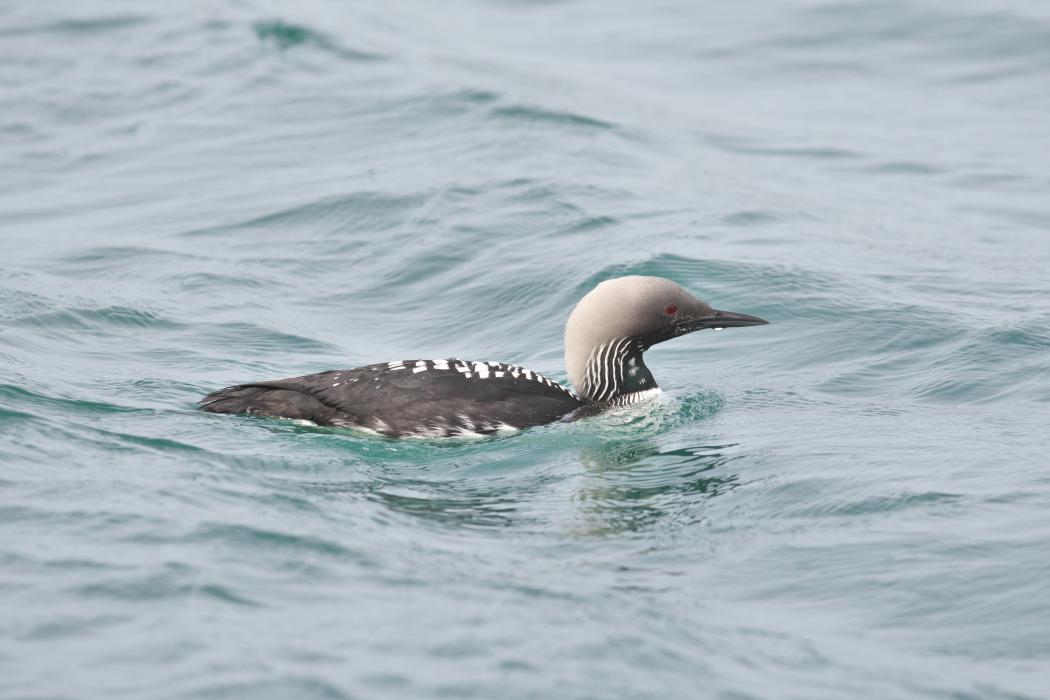Species Profile: Pacific Loon

The Pacific loon is thought to be the most abundant loon in North America. It weighs between 2.2 and 5.5 pounds (1000 and 2500 grams), has a wingspan of up to 4.2 feet (128 centimeters) and is about 2 to 2.5 feet (58 to 74 centimeters) in length.
Pacific loons spend most of their time in the ocean’s open waters, with the exception of a three-month breeding season spent on freshwater lakes in northern Canada, Alaska and Siberia. They forage for food by dipping their head under the water and then diving, propelled by their feet, when they spot a prey item. Throughout the year, these birds mainly feed on fish and aquatic invertebrates, like insects and mollusks, which they swallow whole while underwater.
While loons are very agile in the water, they move awkwardly on land. In fact, they can only take off from the water. They require a stretch of 100 to 165 feet (30 to 50 meters) of water to achieve flight, flapping their wings along the surface until they lift off.
Breeding
Pacific loons breed in tundra lakes in northern Canada, Alaska and Siberia. They tend to prefer deep, freshwater lakes without a lot of submerged vegetation, especially those with small islands they can use for nesting. In the southern part of their range, the loons begin breeding in March. In the northern part of their range, breeding timing depends on the arrival of spring.
Pairs of loons bond with each other by performing courtship displays that involve simultaneous diving and head movements. The same pair of loons will return to the same breeding grounds to mate with each other year after year. Both the male and the female of the pair help build the nest, which is just a depression in the ground or a heap of vegetation. They build a nest close to their breeding pond, so they can easily escape to the safety of the water if threatened.
The female lays one to two eggs, and both parents take turns incubating the eggs until they hatch. The chicks leave the nest one to two days after hatching and are able to swim immediately but will not be able to fly until they are about 50 to 55 days old. Parents forage for food in the freshwater breeding ponds and in the nearby ocean. Both parents feed the young until they are old enough to forage for themselves and disperse to new areas, at around 57 to 64 days old.
Migration
During migration, loons shift from freshwater breeding habitats to coastal marine habitats. Migration typically occurs during the daytime and in small flocks. Loons do not stop on land to rest during migration but instead will rest in open ocean waters. The marine habitats chosen as stopovers during migration tend to have high concentrations of tiny organisms called zooplankton. These zooplankton attract larger prey items, such as fish, that the loons will eat.
Overwintering
Pacific loons spend their winters in the coastal waters off North America’s Pacific coast, as far south as Baja California, or Asia’s Pacific coast, as far south as eastern China. During this time of the year, they rely entirely on the ocean for food.
Pacific loons are more social than other loon species and have been observed feeding cooperatively with Arctic loons. Their cooperative feeding behavior was even the basis of a traditional Japanese fishing method, called loon fishing.
Fishermen observed the loons fishing cooperatively by swimming under and around schools of sand lance, small fish. The fish were forced to the surface in a tight cluster where they could easily be caught. Fishermen would target larger species of fish that would also come to feed on these clusters of sand lance. Using this method, fishermen could earn their entire yearly livelihoods in just two months.
Conserving the Pacific Loon
Pacific loons are abundant, but many populations face challenges from humans. One of the threats to Pacific loon populations is harmful algal blooms that can occur in oceans or freshwater bodies. An algal bloom happens when algae grows out of control.
Some algal blooms produce toxic chemicals that can kill birds and other wildlife. In 2007, an algal bloom killed more than a thousand seabirds off the northwest Pacific coast, including migrating Pacific loons. Algal blooms are caused by rising ocean temperatures due to climate change, as well as by fertilizers used on farms that make their way into our oceans and other waterways. Efforts to curb climate change and reduce runoff from agricultural fields can prevent algal blooms.
Toxic chemicals, such as mercury, that are produced by coal-fired power plants become more concentrated the closer you get to the North Pole. Because the Pacific loon breeds so far north, it is vulnerable to the harmful effects of these chemicals. Efforts to reduce pollution and our reliance on coal power can reduce this threat.
